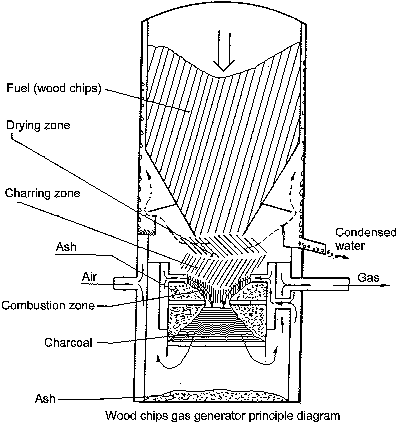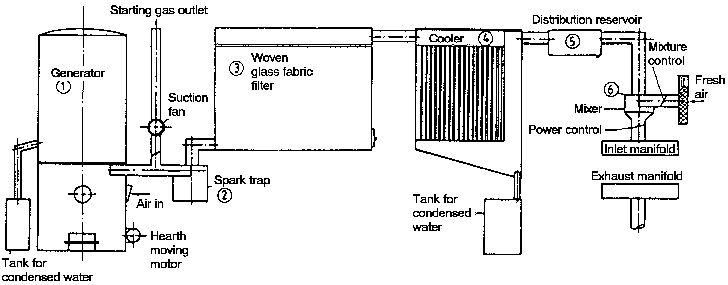
 Gas Generation
Gas Generation
- Principle of operation
 The main problem with
producing wood gas for an ICE
(Internal Combustion Engine) is
to produce gas without tar and
acids. This goal is normally
achieved using a forward flow
gas generator. Air is passed into
the generator through the holes
(air nozzles) in the middle of the
generator mantle. Burning takes
place in downward direction.
Both the gas and the fuel flow in
the same direction. The carbon
monoxide is sucked through the
hearth. The gas is not taken out
from below but the gas flow is
guided to flow upwards along
the wall around the combustion
chamber. The flowing gas heats
the intake air and this increases
the efficiency of the generator. From the generator the gas passes through the filter
and cooler to the mixer.
The main problem with
producing wood gas for an ICE
(Internal Combustion Engine) is
to produce gas without tar and
acids. This goal is normally
achieved using a forward flow
gas generator. Air is passed into
the generator through the holes
(air nozzles) in the middle of the
generator mantle. Burning takes
place in downward direction.
Both the gas and the fuel flow in
the same direction. The carbon
monoxide is sucked through the
hearth. The gas is not taken out
from below but the gas flow is
guided to flow upwards along
the wall around the combustion
chamber. The flowing gas heats
the intake air and this increases
the efficiency of the generator. From the generator the gas passes through the filter
and cooler to the mixer. -
- In the mixer the gas is mixed with fresh air and the mixture is taken into the ICE.
The system is started using a suction fan or a blowing fan to produce air/gas flow in
the generator. Lighting up the generator is done either using an electric glow device
or some sort of flame.
-
- Operation
- The gas is produced in the gas generator as a result of partial burning. Air is taken
into the generator through the air nozzles. The fuel that lies near the nozzles burns.
The generated heat dries and chars the fuel above. New fuel (to replace that already
used) enters the combustion chamber from the reservoir above. The gases produced
in the combustion zone and part of the water vapor go downwards into the glowing
coal layer just above the hearth. The temperature of this coal layer is more than 800
°C.

- When going through the coal layer carbon dioxide reacts with the coal. This
reaction produces carbon monoxide:
- CO2 + C = 2CO
- The water vapor reacts with the glowing coal. This reaction produces hydrogen and
carbon monoxide:
- H2O+C = H2+CO
- Due to these reactions the generated gas includes hydrogen and carbon monoxide
and other substances listed below:
- CO : 17 - 22 %
- H2 : 16 - 20 %
- CH2 : 2 - 3 %
- CnHm : 0,2 - 0,4 %
- C02 : 10 - 15 %
- N2 : 45 - 50 %
- The ash produced in the combustion process goes through the hearth onto the bottom
plate of the generator. If wood chips are used as the fuel the hearth must be
equipped with a moving mechanism to ensure free gas flow through the coal layer.
If the hearth is rigid the fine ash produced in the combustion process clogs the coal
layer quite soon. The heat generated in the combustion process vaporizes the water
in the unburned fuel and the produced vapor flows to the inner walls of the fuel
reservoir and condenses back to water. This water is collected in a special tank
from where it can easily be removed when the system is stopped.
Translated by Olli.



![]()
 The main problem with
producing wood gas for an ICE
(Internal Combustion Engine) is
to produce gas without tar and
acids. This goal is normally
achieved using a forward flow
gas generator. Air is passed into
the generator through the holes
(air nozzles) in the middle of the
generator mantle. Burning takes
place in downward direction.
Both the gas and the fuel flow in
the same direction. The carbon
monoxide is sucked through the
hearth. The gas is not taken out
from below but the gas flow is
guided to flow upwards along
the wall around the combustion
chamber. The flowing gas heats
the intake air and this increases
the efficiency of the generator. From the generator the gas passes through the filter
and cooler to the mixer.
The main problem with
producing wood gas for an ICE
(Internal Combustion Engine) is
to produce gas without tar and
acids. This goal is normally
achieved using a forward flow
gas generator. Air is passed into
the generator through the holes
(air nozzles) in the middle of the
generator mantle. Burning takes
place in downward direction.
Both the gas and the fuel flow in
the same direction. The carbon
monoxide is sucked through the
hearth. The gas is not taken out
from below but the gas flow is
guided to flow upwards along
the wall around the combustion
chamber. The flowing gas heats
the intake air and this increases
the efficiency of the generator. From the generator the gas passes through the filter
and cooler to the mixer. 